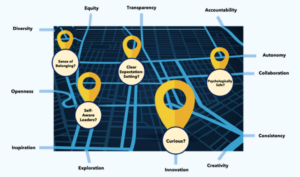
A Bad Workplace Culture Can Result in a Disaster, No Matter the Industry
A bad workplace culture is a hazard in itself. But even a mediocre one can contribute directly to a disaster. NASA won awards for being

A bad workplace culture is a hazard in itself. But even a mediocre one can contribute directly to a disaster. NASA won awards for being

Modern organizations depend on people to work effectively within teams. Arguably, teamwork is even more important now, as businesses navigate diverse challenges, from constant technology

Sponsored by The Culture Platform What makes maps so special is they tell you exactly where to find places you want to visit. Wouldn’t it

Management advice is everywhere. But how do you know which guidance to trust? To find truly useful answers, we asked business executives to answer this

Sponsored by The Culture Platform What tools actually help managers manage their people? That’s the most important question every organization needs to ask itself as the

In today’s fluid, fiercely competitive business environment, many organizations continuously strive to stay ahead of the curve. They know success requires an ongoing commitment to

Sponsored by Social Flowers What a difference three years can make! I’m sure that’s what many remote employees are thinking these days. Before the pandemic,

The pandemic has sparked a global conversation about whether people who’ve been working from home should be free to choose their preferred work location. It’s

As 2022 draws to a close, most organizations are deeply involved in planning, budgeting and forecasting for the coming year. To complete this rigorous process,

Sponsored by: ADP Employers are looking for new ways to stand out in terms of employee perks and benefits. One solution: earned wage access (EWA).

Sponsored by: ThoughtExchange For several months, we’ve been sharing insights from our partner ThoughtExchange. They’ve done some fascinating research on Gen Z employees, employee experience,

2021 turned out to be a year that introduced many new terms into the common vocabulary. One of the most popular terms – The Great

Many business experts champion trust in the workplace. They include the likes of Stephen Covey and my dear friend, David Horsager. (His 8 Pillars of

Building an in-house human resources department for your business, or a company where people can outsource their HR needs to you? The initial steps can

It’s been a hard year and a half, and as the pandemic continues to fluctuate, illness and lockdowns have taken their toll. The effects extend

What is a great “place” to work today? With many abandoning the office tower or business park cubicle office, we’re increasingly emerging from an era
Earlier this year, Gallup issued a fascinating study that looked at why great managers are so rare. It concluded that while one of the most
Every organization would like to build a high performance stand-out culture, but these ten non-strategic activities are barriers that must be overcome. They are practised
Every organizational strategy needs regular updating regardless of how successful you’ve been. It’s simply not good enough to develop your strategy and put it on
Most organizations realize the need for (and huge bottom-line benefits of) an engaged workforce, but the majority still struggle with it.
Satisfying your customers isn’t good enough in today’s competitive markets. Meeting their needs falls short of earning their loyalty. You need to dazzle them; leave
It’s not unusual for employees to be driven to succeed, especially in a company which is striving for success and prides itself on hiring highly
Millennials are feeling the crush of student debt—but they aren’t the only ones. Generation Xers and Baby Boomers are also struggling to pay off their
“Now that ain’t workin’ that’s the way you do it Lemme tell ya them guys ain’t dumb Maybe get a blister on your little finger
While a lot of companies are still struggling with millennials, smart HR managers are already looking at Generation Z, oldest of whom are turning 18